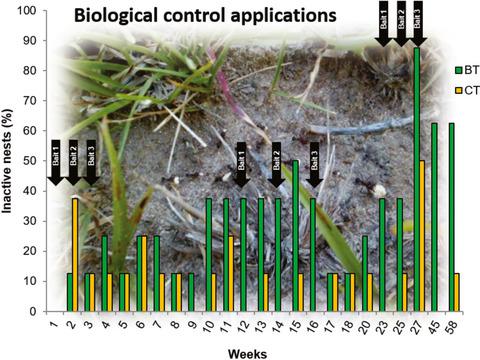当前位置:
X-MOL 学术
›
Entomol. Exp. Appl.
›
论文详情
Our official English website, www.x-mol.net, welcomes your feedback! (Note: you will need to create a separate account there.)
Biological control of leaf-cutter ants using pathogenic fungi: experimental laboratory and field studies
Entomologia Experimentalis et Applicata ( IF 1.9 ) Pub Date : 2021-06-21 , DOI: 10.1111/eea.13078 PJ Folgarait 1 , D Goffré 1
Entomologia Experimentalis et Applicata ( IF 1.9 ) Pub Date : 2021-06-21 , DOI: 10.1111/eea.13078 PJ Folgarait 1 , D Goffré 1
Affiliation

|
The alternative use of biological control agents (BCAs) against leaf-cutter ants (LCAs) is in increasingly high demand due to the negative consequences of traditional pesticides. Regarding LCAs, BCAs include entomopathogens that infect them, and mycopathogens that kill the fungi cultivated by these ants. The simultaneous use of multiple BCAs requires that the agents do not negatively affect each other. To test this hypothesis, we set up laboratory assays to evaluate in vitro interactions among an entomopathogen [Beauveria bassiana (Bals.-Criv.) Vuill.], a mycopathogen [Trichoderma virens (JH Mill., Giddens & AA Foster) Arx], and the LCA-cultivated symbiotic fungus Leucoagaricus sp. We also tested the BCAs in the field by offering them in three types of bait to Acromyrmex lundii Guérin-Méneville (Hymenoptera: Formicidae), in order to evaluate: (1) the control efficiency of these BCAs on LCA field colonies, and (2) whether there was delayed rejection of baits placed sequentially. Our in vitro results showed that T. virens was not affected by Leucoagaricus sp. or by B. bassiana, whereas B. bassiana was negatively affected by the mycopathogen and the cultivated fungus, probably due to substrate competition. Leucoagaricus sp. was not affected by B. bassiana but it was negatively affected by T. virens, as predicted, destroying the cell walls of the cultivated fungus. The field study showed 62.5% control of LCA after applying the three types of bait on three occasions throughout 27 weeks, without detecting any delayed rejection effect. Due to the variability registered in colony inactivity, we propose a continued inactivity of 13 weeks as a criterion for A. lundii control. We discuss the importance of continuous long-term assessments of BCAs on LCA control.
中文翻译:

使用病原真菌对切叶蚁进行生物防治:实验室和田间研究
由于传统杀虫剂的负面影响,对切叶蚁 (LCA) 的生物防治剂 (BCA) 的替代用途的需求越来越高。关于 LCA,BCA 包括感染它们的昆虫病原体,以及杀死这些蚂蚁培养的真菌的真菌病原体。同时使用多个 BCA 要求代理不会相互产生负面影响。为了验证这一假设,我们建立了实验室检测来评估昆虫病原体 [ Beauveria bassiana (Bals.-Criv.) Vuill.]、一种真菌病原体 [ Trichoderma virens (JH Mill., Giddens & AA Foster) Arx]之间的体外相互作用,和 LCA 培养的共生真菌Leucoagaricussp. 我们还通过向Acromyrmex lundii Guérin-Méneville(膜翅目:蚁科)提供三种类型的诱饵,在田间测试了BCA,以评估:(1)这些 BCA 对 LCA 田间菌落的控制效率,以及(2 ) 是否有延迟拒绝顺序放置的诱饵。我们的体外结果表明T. virens不受Leucoagaricus sp. 的影响。或由B. bassiana,而B. bassiana受到真菌病原体和栽培真菌的负面影响,可能是由于底物竞争。Leucoagaricus sp. 不受B. bassiana 的影响,但受到T. virens 的负面影响,正如预测的那样,破坏培养的真菌的细胞壁。现场研究表明,在整个 27 周内,在 3 次使用三种类型的诱饵后,LCA 的控制率为 62.5%,没有检测到任何延迟排斥效应。由于菌落不活动记录的可变性,我们建议将 13 周的持续不活动作为控制A. lundii的标准。我们讨论了持续长期评估 BCA 对 LCA 控制的重要性。
更新日期:2021-08-19
中文翻译:

使用病原真菌对切叶蚁进行生物防治:实验室和田间研究
由于传统杀虫剂的负面影响,对切叶蚁 (LCA) 的生物防治剂 (BCA) 的替代用途的需求越来越高。关于 LCA,BCA 包括感染它们的昆虫病原体,以及杀死这些蚂蚁培养的真菌的真菌病原体。同时使用多个 BCA 要求代理不会相互产生负面影响。为了验证这一假设,我们建立了实验室检测来评估昆虫病原体 [ Beauveria bassiana (Bals.-Criv.) Vuill.]、一种真菌病原体 [ Trichoderma virens (JH Mill., Giddens & AA Foster) Arx]之间的体外相互作用,和 LCA 培养的共生真菌Leucoagaricussp. 我们还通过向Acromyrmex lundii Guérin-Méneville(膜翅目:蚁科)提供三种类型的诱饵,在田间测试了BCA,以评估:(1)这些 BCA 对 LCA 田间菌落的控制效率,以及(2 ) 是否有延迟拒绝顺序放置的诱饵。我们的体外结果表明T. virens不受Leucoagaricus sp. 的影响。或由B. bassiana,而B. bassiana受到真菌病原体和栽培真菌的负面影响,可能是由于底物竞争。Leucoagaricus sp. 不受B. bassiana 的影响,但受到T. virens 的负面影响,正如预测的那样,破坏培养的真菌的细胞壁。现场研究表明,在整个 27 周内,在 3 次使用三种类型的诱饵后,LCA 的控制率为 62.5%,没有检测到任何延迟排斥效应。由于菌落不活动记录的可变性,我们建议将 13 周的持续不活动作为控制A. lundii的标准。我们讨论了持续长期评估 BCA 对 LCA 控制的重要性。



























 京公网安备 11010802027423号
京公网安备 11010802027423号